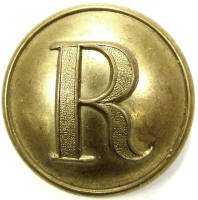
A virtual examination of artifacts of the American Civil War
 | Ridgeway Civil War Research Center,
A virtual examination of artifacts of the American Civil War |
| Civil War Artillery | |
| by Harry Ridgeway |
| Rifled artillery projectile, Britten design, English manufacture, solid bolt, pattern with long rounded nose, lead cup sabot, 10 pounder rifle, 2.9 in. or Ordnance rifle, 3in. Projectile was manufactured by the English and exported to the American conflict, either side could purchase them, but primary use was southern. The design follows Britten's English patent, employing a lead cup sabot with a counter bulge or large concave teat that extends beyond the bottom. Bolt was turned on a lathe, when sabot is missing there is lathe dimple and lathe marks on bottom, some will have ring around the nose which probably was left from it being clamped to the lathe, American producers tended to use knobs. Projectile measures smaller than 2.9 in. suggesting that it may have originally been intended for the 10 pounder, however, the short length with a soft lead sabot would not have been suited at all for a 3 groove 10 pounder 2.9in. rifle, those missing the sabot may have been fired from this rifle, the torque from firing 3 groove would tend to rip the sabot away. All examples recovered with fired sabot remaining show 7 grooves suggesting most were actually fired from a 3 inch rifle, it would have fit loose in a 3 inch bore and this would account for the weak rifling. It is speculated that this pattern was originally manufactured for the smaller 2.9in. rifle, but most were used in the 3in. rifle as a practical solution. Projectile measures: diameter 2.45in., length 5.25in. (excluding sabot), weight 5.7lbs., without sabot. Research Center: Artillery3411-Britten, Ref: Dickey & George, Field Artillery (1993 Edition), pg. 108. Details click: http://relicman.com/artillery/Artillery3411-Britten.html. |
| Ridgeway Civil War Research Center, A virtual examination of artifacts of the American Civil War. Artillery Research center, artillery, click: http://relicman.com/artillery/Artillery0000-Index.html. Research center, artillery, click: http://relicman.com/artillery/Artillery0000-Index.html. |
| Civil War Relicman, Harry Ridgeway, Civil War artillery, Relicman sales catalog. Click here: http://relicman.com/artillery/RelicmanSalesArtillery1.html. Artillery for sale: http://relicman.com/artillery/RelicmanSalesArtillery1.html. |